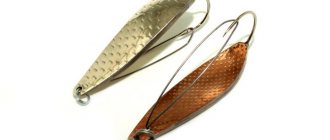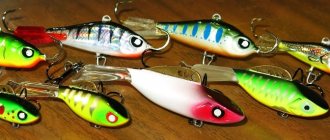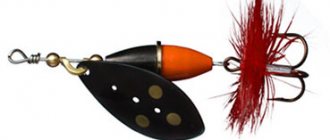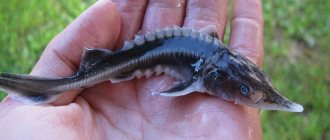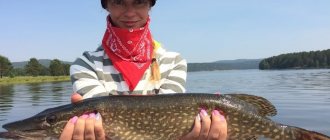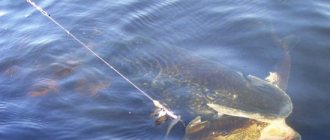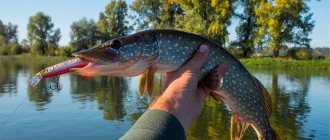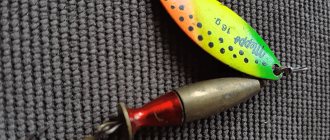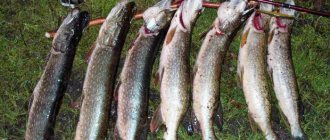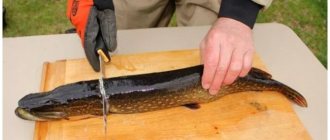Distribution and habitats of pike
Pike lives only in freshwater bodies of water or in desalinated parts of the seas. Found in the Northern Hemisphere (Eurasia, North America). Spotted fish prefers low-flowing or stagnant waters. A suitable parking lot must meet a number of requirements:
- sandy bottom;
- presence of aquatic vegetation;
- edges, pits;
- flooded snags and trees;
- Differences in depth are desirable.
Pike does not live in mountain rivers with fast currents and rocky bottoms due to the impossibility of setting up an ambush here. Also, the spotted one does not like small ponds, which “bloom” in the summer and are completely covered with ice in the winter.
Typical habitats are small and large rivers, lakes, ponds, reservoirs and other artificially created reservoirs. As an exception, you can meet grass pike even in some swamps. Preferred stopping places for the spotted fish are floodplain lakes, river beds and bays.
Where to look for pike
Promising places for pike to stay differ for each specific body of water. The fisherman needs to know and take into account the hydrological features of the selected water area.
In a river
Pike set up ambushes in the most hidden and protected places. These are aquatic plants, fallen trees, snags or single boulders along the shoreline.
Typical habitats of pike on the river:
- steep coastline with depth changes;
- deep hole - a junction of two or more rivers;
- the area immediately behind the dam.
You can find pike on the river in other, most unpredictable places. Changes in weather conditions and surges in atmospheric pressure force the spotted fish to migrate across the water area.
On small rivers
If the bed of a small river has a minimum depth of 1-1.5 m and small fish (bleak, roach) are found here, pike lives in this reservoir. But the shallower the river, the more careful the pike. A fisherman in such waters must exercise maximum camouflage and caution.
In a lake, pond
Here the toothy predator usually stays in shallow water areas near snags and abundant aquatic vegetation. There are high chances of finding pike near reeds, sedges, and water lilies.
Pond pike
In the reservoir
Promising places for fishing are the mouths of flowing rivers, vast shallow waters, and areas with thickets of aquatic plants. Pike can go deep and stay close to hydraulic structures. It is recommended to use a watercraft for fishing in the reservoir.
About
Features of fishing for pike in the current
Pike on the river behaves a little differently than in a closed water area; the predator will not scour everywhere in search of food. She, one might say, is an ambush predator, chooses a convenient place for herself to catch her favorite delicacy, reserves patience and waits for her finest hour. It is these subtleties of behavior that you should base your future fishing on the river on.
Catching pike on a river can only be done by knowing the following subtleties:
- the toothy predator always stands next to a natural shelter;
- it stays slightly above the natural obstacle, and always attacks only with the flow;
- It will be possible to find a predator in the shallows only in cool or windy weather;
- river pike shows minimal activity at night;
- in places with fast currents it is useless to look for a trophy;
- You can find large pike in the river only in deep holes; giants practically never go to the shallows;
- in places where peaceful fish accumulate nearby, pike will also be in ambush;
- rivers with changeable bed topography are rich in pike; the predator loves all sorts of irregularities.
But you shouldn’t look for the predator on the rocks; it prefers sandy, clayey shores and bottom.
Pike on the river will respond perfectly to the standard bait of a spinning rod, will not pass by a float tackle with live bait, and sometimes does not mind eating a worm. Pike are rarely caught using a cast in a pond with a current; few people can boast of such a trophy.
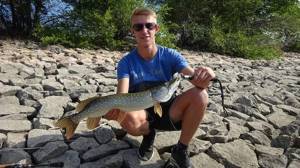
What can you offer the pike so that it pays attention? How to interest a predator?
| type of fishing | baits used |
| spinning | wobblers, silicone, spinners |
| float tackle | live bait, worm |
| mugs | live bait |
Each of the baits will be to your taste, but not always. When fishing for pike in reservoirs with a current, it is worth taking into account weather conditions: pressure surges, wind, and heat also affect river inhabitants.
What time of day is best to catch pike?
Each individual population living in a specific water area develops its own biological rhythm of existence. For example, in one lake the predator actively bites before dawn, in another - before sunset. Therefore, all of the above recommendations are general; they may vary for each specific body of water.
| Times of Day | Peculiarities of biting |
| Dawn (early morning) | The pike “wakes up” and sets up an ambush as early as 4-5 o’clock in the morning. An additional advantage for the fisherman is poor lighting (it is difficult for fish to distinguish live fish from bait). The chances of catching a large specimen are highest in the morning. |
| Daytime hours | In good sunny and clear weather, the bite is completely exhausted by noon. The predator accurately sees its real victim; it does not attack artificial baits. On a gloomy, cloudy day and drizzling rain, you can fish during the day, since visibility in the water is significantly deteriorated. |
| Evening time | If the bite has been stopped, it will resume only at 18-19 hours. From 19 to 22-23 increased activity of the predator remains. |
| Night | After midnight the pike does not bite. This is due to the fact that small fish (the main food source of the predator) have stopped all their movements in the reservoir. |
The influence of weather on pike biting
When planning a fishing trip, be sure to take into account the weather forecast. Under unfavorable conditions, the bite may be completely absent, as the fish will leave its usual places and hide.
In what weather does pike bite better?
Suitable weather conditions depending on periods and months.
- From January to April – fishing will be successful on sunny and clear days.
- Mid-May-June – pike have a seasonal feeding period and are quite active in any weather.
- July August. The worst weather for pike is sunny afternoon. The bite intensifies only after the heat of the day subsides (evening, morning).
- Late September-October, November – fishing will be successful in cloudy weather and light drizzle with moderate wind.
- December-January – the weather “doesn’t matter”.
At what pressure does pike bite best?
Optimal indicators are stability and constancy, absence of jumps and drops. It does not matter what kind of pressure, high or low. If the pressure is relatively stable for 3-4 days, fishing success is guaranteed.
At what water temperature does pike bite?
Pike is a fairly “cold-resistant” fish. It is perfectly adapted to low temperatures; the spotted one tolerates the summer heat much worse. Optimal temperatures vary from -7 – -5 to +15 – +20.
Pike fishing in open water
There are several ways to catch pike during the open water season. Pike can be caught with a spinning rod, with a float rod, with live bait, with a donka, with summer baits and with mugs.
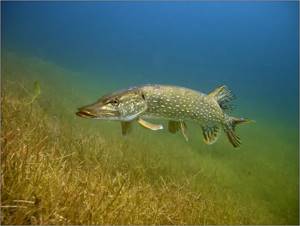
Some of these methods require the presence of a boat, others can be carried out both from a boat and from the shore. Each angler chooses for himself the method that suits him best based on the conditions in which he has to fish, the availability of certain fishing gear, and his personal preferences in fishing.
Spinning
Pike fishing with a spinning rod is the youngest, and at the same time, the most popular way of catching this predatory fish. The principle of spinning fishing is to cast the bait using a rod and then retrieve it by rotating the reel and moving the rod.

Fishing for pike with a spinning rod involves constantly moving the angler around the reservoir to search for active pike, changing baits and constantly experimenting with a variety of fishing rods. You can catch pike with a spinning rod throughout the open water season, from early spring to late autumn, with the exception of the time of spawning ban. Fishing for pike with a spinning rod can be done both from the shore and from a boat, but as a rule, a boat greatly expands the angler’s capabilities.
For pike fishing, a spinning rod is used, equipped with a spinning reel on which a cord is wound, to which an artificial bait is attached through a leash. Pike fishing with spinning rods can be done both from the shore and from a boat. To catch pike from the shore, use a rod with a length of 2.7 m, and when fishing from a boat it is easier to use a shorter rod with a length of 2.1-2.4 meters.
The diameter of the fishing line (cord) is selected taking into account the expected size of the prey. For pike fishing, both braided lines and monofilaments are used.
When fishing for pike, you must use a leash, the function of which is to protect the fishing line from the sharp teeth of the pike. The leash is most often made of Kevlar, titanium, tungsten or guitar string. Some fishermen use fluorocarbon leashes when fishing for pike; they are almost completely invisible in the water, but are less resistant to pike teeth than metal leashes.
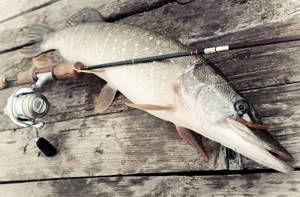
A wide variety of spinning lures are used for pike fishing:
Oscillating spinners -
one of the oldest spinning baits. They are a metal plate curved in the longitudinal or transverse direction, in the tail part of which a tee is fixed. When moving in the water, the oscillating spoon moves from side to side, rolls from side to side or trembles slightly, creating vibrations of a certain amplitude and frequency that attract predatory fish. Oscillating spoons are used for catching pike both in still water and in the current. Oscillating spoons are quite versatile, easy to use and inexpensive, which is why they are very popular among anglers.
Spinners
easy to use and catchy, most beginning spinners begin their journey in spinning by fishing with spinners. Spinner baits consist of a wire rod on which is attached a metal petal and a treble hook. When the spoon moves in the water, during the retrieve, the petal rotates around the rod, creating high-frequency vibrations and glare in the water that attract predators. Rotating spoons have numbers that indicate the size of the blade of the spoon, spoons come in sizes from 00 to 6. For catching small and medium-sized pike, rotating spoons numbered 2 and 3 are well suited; for catching large pikes, spinners numbered 4 to 6 are used.
Silicone baits
are a very popular class of lures for pike fishing. Silicone baits come in a wide variety of shapes and types, the most common among them: twisters, vibrotails, worms, octopuses, crustaceans, frogs. Many types of silicone baits resemble in their appearance real food items of predatory fish, others are completely fantasy. Silicone baits are divided into edible and inedible; attractants are added to edible baits, which additionally attract fish with their smell and taste. Silicone baits are available in a large number of different colors. For fishing, silicone baits are mounted on a jig head or on an offset hook connected to an eared sinker (Cheburashka). Lately, fishing with spaced-out rigs has become increasingly popular among spinning anglers: retractable leash, drop-shot, Carolina and Texas rigs. The method of fishing with silicone baits is called jig.
You may be interested in: Microjig
Wobblers
are solid baits, their appearance resembling fry and intended for catching predatory fish. Wobblers can be of different sizes. To catch large pike, you can use wobblers with a length of 100 mm and above. For catching medium-sized pike, wobblers 7-10 cm long are suitable. Wobblers vary in shape, each of which has its own name: minnow, shad, crank, fat and others. Good results when fishing for pike are shown by minnow wobblers, which are carried out with a special jerking retrieve called twitching. Other types of wobblers show good results: shads, poppers, cranks. Wobblers vary in the degree of buoyancy; they are: floating, suspended and sinking. Wobblers also vary in depth, they can be: surface, subsurface, shallow, deep, ultra-deep. Depending on the fishing conditions, the angler selects a wobbler that is suitable in terms of its parameters and characteristics.
Live bait fishing rod
Many anglers catch pike on a float rod with live bait attached to a hook. To catch pike with a fishing rod, anglers use a long telescopic rod, which allows them to cast into windows of clear water. An inertial or spinning reel is installed on the fishing rod; most anglers use a spinning reel, which is much easier to use.
A leash must be installed between the fishing line and the hook, which can be metal, Kevlar, titanium, tungsten, guitar string or fluorocarbon fishing line. Fluorocarbon leashes are less noticeable in the water, but less resistant to pike teeth than metal leashes.
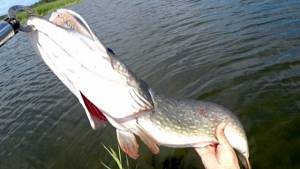
The float must be special for fishing with live bait; it is barrel-shaped and has a large carrying capacity so that the live bait cannot drown it. The float must be loaded up to the antenna. You can buy a float at a fishing store or make it yourself from a champagne cork. The float should be visible at a distance of up to 20 meters. The hooks used are relatively small; they can be triple, double or single.
When choosing live bait, you should take into account the degree of its survivability; pike prefers live and active fish; it most often ignores dead ones. Good bait for live bait: small crucian carp, carp, gudgeon, roach. It is best to catch live bait in the same body of water where fishing will take place; pike are more willing to catch food that is familiar to it. If there are a lot of frogs in the body of water where you are fishing for pike, they are most likely a frequent prey for pike, so fishing for a frog will most likely be successful. Live bait must be released into the water.

Fishing for pike with a live bait rod is most effective in the summer on small rivers with gentle currents and heavily overgrown reservoirs with standing water. It is better to catch pike with a live bait rod from a boat in order to increase the number of places fished.
After casting live bait, the fisherman waits five to seven minutes; if during this time there is no bite, he should move to another place. The fisherman can periodically return and re-fish old fishing spots that have already been fished.
Bottom fishing rod
A bottom fishing rod is not the best tackle for catching pike. In summer, pike stay in thickets of underwater vegetation, in snags. In such places there is no opportunity to perform a normal cast and to land the caught pike on the bottom tackle.
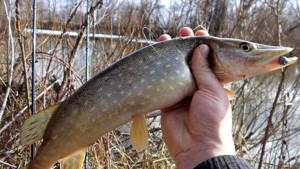
Many anglers successfully catch pike using bottom tackle in water bodies that are clear of underwater vegetation and snags. At the same time, they use both a classic donk and a donk with a rubber shock absorber. The best time for such fishing is spring, when the underwater vegetation has not yet had time to grow, and late autumn, when the bulk of the underwater vegetation has already died off. You can cast bottom gear along the shallows where pike come out to feed. You can use live bait or a frog as bait. Pike of all sizes are caught with live bait, and, as a rule, the largest individuals are caught with frogs.
If you choose between a classic donka and bottom tackle with a rubber shock absorber, then you should give preference to rubber, which does not require the use of a boat for repeated casts and creates much less noise that scares away pikes.
Catching pike with summer baits
The supply rig is the oldest equipment for catching pikes. The zherlitsa has an extremely simple device. You can fish with a zherlitsa on a pond, lake or small river. Grills are installed in places where pike often hunt for small fish: in windows among aquatic vegetation, under trees overhanging the water, next to flooded bushes.
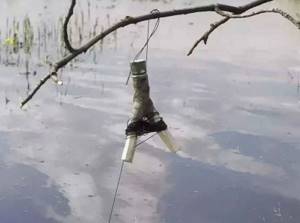
The zherlitsa consists of:
- A reel, which can be made from a wooden flyer with splits at the ends, from a plank, plywood or even a plastic bottle.
- Fishing line of sufficient strength, wound on a reel, at least 7 meters long
- A lead sinker, which is needed to hold live bait so that it does not go into the grass
- Fluorocarbon leader tied to the fishing line via a swivel
- Hook, quite large in size, which can be triple, double or single
Live bait is attached to the hook of the girder and the tackle is thrown into the water. The best live bait for catching pike in summer: bleak, dace, perch, roach, gudgeon. The fishing line is inserted into the split of the flyer in such a way that when the pike takes the bait, the fishing line is released from the split, and later, when the fishing line finishes unwinding, the pike will hook itself. The reel is tied to a tree and a pole driven on the shore or in the water.

Anglers who fish with girders install several girders in the most promising places in the reservoir, and, as a rule, leave them overnight. In the morning, fishermen go around the girders one by one and check them.
Fishing with mugs
A circle is a floating version of a summer vent. The circle is a foam float in the form of a disk, which has a groove for winding fishing line at the end. Different sides of the disk are painted in different colors, usually white and red. When a pike grabs a live bait, the circle turns over with its bright side up, alerting the angler to a bite.
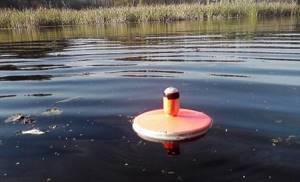
There are two ways to catch pike with mugs. The first method is used on calm rivers and lakes; mugs with attached hooks are allowed to float freely. The mugs slowly float through the water, under the influence of the current and the force of the wind, and look for the pike themselves. The second method of fishing with circles is to secure the circles in one place using a fishing line with a sinker attached to it. In this case, the mugs are placed near snags, next to thickets of grass, that is, in those places where actively feeding pike often hang out.
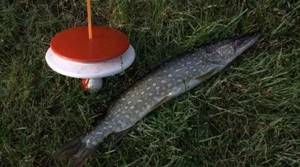
Pike fishing with mugs is done from a boat. In order to catch the maximum area of the reservoir, the mugs are installed or floated in a checkerboard pattern. The mugs must be within the angler’s visibility at all times so that he can react to pike bites.
It is best to use live bait taken from the same reservoir where pike fishing will be carried out for baiting mugs. Live bait is placed at half-water or forty centimeters from the bottom. During the fishing process, the fishing horizon is changed, depending on which horizon the bites most often occur on.
You may be interested in: Rating of spinning reels

The fisherman must constantly monitor the circles and as soon as one of them is triggered, he slowly and carefully, trying not to scare off the pike that took it, swims up to the triggered circle. The fisherman carefully collects the line into the boat, and as soon as he feels the heaviness, he makes a hook and begins to fish out the caught pike. Pike are caught in circles throughout the open water season, but the best time for this method of pike fishing is September-October, the time of the autumn pike feeding season.
Seasonal features
| Winter | At the beginning of the season, pike still retain moderate activity and mobility. The fish does not want to waste energy and bites almost immediately. In the depths of winter, pike live in the depths and hide there; fishing comes to a standstill. Towards the end of winter, the activity of the spotted fish begins to gradually revive, and the pike goes hunting. |
| Spring | After the ice melts, the pike goes to spawn. During spawning, individuals are inactive and lethargic, making them difficult to catch. After spawning, there are 14 “golden” days, when the pike begins to eat, it bites on everything indiscriminately. |
| Summer | Fishing is extremely difficult. Pike is capricious and picky. The predator goes into the depths and almost completely loses its appetite. In summer it is extremely difficult to guess with bait. |
| Autumn | The best time to hunt pike. After the heat subsides, the glutton for fat gain begins (preparing for the coming winter). Pike hunt intensively, and the chances of catching large specimens are high. |
The largest specimens
The Book of Records contains facts about the largest pikes that were caught by people. A muskellunge pike was caught on the St. Lawrence River (New York), weighing 32 kg. Even the help of equipment was needed to pull out the catch. In the Netherlands, a long specimen was caught - 120 cm, but it took only 10 minutes to catch it. The record was later broken: in 2011, a pike 130 cm long was caught in Canada (St. Lawrence River).
Record-breaking pike from Russia
The first large specimen was caught in 1930. The weight of the trophy was 35 kg. The place of the record is Lake Ilmen. Later, an even larger fish was caught - a pike weighing 49 kg and 200 g (Lake Ladoga, Sortavala). The record holder was caught using live bait; the live bait was another pike, weighing 5 kg.
Today in Russia, record-breaking pike are considered to be individuals whose age is from 20 years, and their weight is from 16 kg. Fishermen often hush up their successes, fearing that the trophy they catch will be taken away.
Pike is a ruthless and cunning predator. Pike lives only in freshwater bodies of water. It prefers clean water with a weak current, but these individuals can, as an exception, be found in swamps. Pike is a fairly smart fish: it sees well in the water and can distinguish artificial bait from live bait. Suitable weather conditions and fishing times vary depending on the time of year.
Views: 1,853
Similar articles:
- Pike fishing in September: what to bite, how to catch pike, its habits. Pike fishing in September is the perfect time to start...
- Pike fishing in November: what to fish for, search and tactics for fishing with a spinning rod November is the harbinger of winter, the “last breath” of autumn. Installed on reservoirs...
- Where to look for pike? Searching for fish on lakes and rivers depending on the conditions of the reservoir and the time of year When catching pike with a spinning rod using artificial bait, the rule applies: “Do not...
- What does pike eat: what does it eat, how and who does it hunt? Is there a fisherman who would not like to catch a pike? Surely...
Constant Search | Important Rules for Pike Fishing
As for fishing directly in a reservoir, there is 1 Important Rule:
3 ways to improve your fish bite!

Over 15 years of active fishing, I have found many ways to improve the bite, and here are the most effective:
1. Bite activator . This pheromone additive attracts fish most strongly in cold and warm water. The Fish Hungry bite activator has proven itself to be excellent - Read more…
2. Tackle with increased sensitivity . You should first familiarize yourself with the features of using a particular type.
3. Pheromone baits . They attract the attention of fish, stimulate hunger and cause a schooling reflex, which allows you to collect a lot of fish in one place.
You can get the rest of the secrets of successful fishing for free by reading my other materials on the site.
3 ways to improve your fish bite!
Over 15 years of active fishing, I have found many ways to improve the bite, and here are the most effective:
1. Bite activator . This pheromone additive attracts fish most strongly in cold and warm water. The Fish Hungry bite activator has proven itself to be excellent - Read more…
2. Tackle with increased sensitivity . You should first familiarize yourself with the features of using a particular type.
3. Pheromone baits . They attract the attention of fish, stimulate hunger and cause a schooling reflex, which allows you to collect a lot of fish in one place.
You can get the rest of the secrets of successful fishing for free by reading my other materials on the site.
The fisherman must look for the pike, and not wait for it to swim to the fishing spot. So, it’s worth periodically changing the place of fishing, without getting hung up on just one thing.
It's Worth Taking a Closer Look at Different Places
Where bushes grow near the water;
Bridge piles are located;
A dam was built from flooded barrels, stones, and snags.
Pike especially loves the Reeds, where there are a lot of small fish, so fishing here is obviously more successful, especially in the summer.
Fish the thickets of Sedges, Water Lilies, places with Aquatic Vegetation, where the water is additionally saturated with Oxygen, which means it attracts small fish, to which the Pike rushes.
That is why it is worth looking for pike and near the spawning grounds of other fish, such as Roach or Crucian carp, where it comes to hunt.
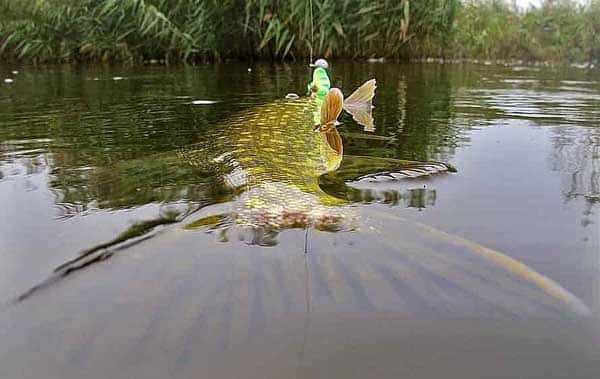
Abandoned reservoirs where the bottom is covered with snags and brushwood are also good. Here you need to look at quiet places, and not look for fish in the middle of a fast current.
You can try fishing in flooded Pits and quarries of large but abandoned Factories and Industries. As Anglers say, here there are great chances to meet really Large pikes, which at the same time pay attention to the bait with pleasure.
Don't Look for Pike:
In small places without much vegetation;
On a sandy bottom or on a too silty one. In a silted reservoir, the chance of catching a fish is small, and only if you put the bait closer to the top of the clear water;
A fast current is also not a help; if there is a pike, it is usually in a calmer place, under cover, that is, the bait should be placed not far from the Bottom.
